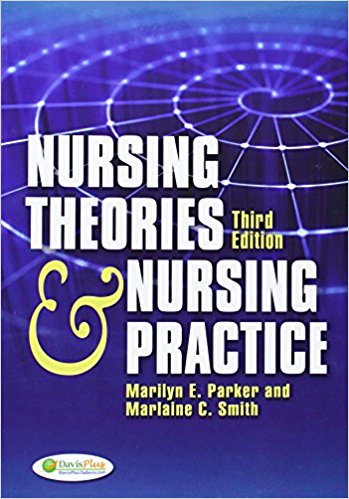Test Bank For Nursing Theories Nursing Practice 3rd Edition Parker
Original price was: $75.00.$35.00Current price is: $35.00.
Test Bank For Nursing Theories And Nursing Practice 4th Edition By Smith is a must have book for every nursing student. This book provides a comprehensive overview of the different nursing theories and their corresponding nursing practices. It also features various practice questions that will help you prepare for your examinations.
Test Bank For Nursing Theories And Nursing Practice 4th Edition By Smith is an essential resource for every nursing student.
Digital item No Waiting Time Instant Download
Description
Test Bank For Nursing Theories Nursing Practice 3rd Edition Parker
Chapter 1
Statement of Intent
The intent of this chapter is to offer an approach to understanding nursing theory within the context of the discipline of nursing, define the discipline of nursing and theory, describe the purpose of theory for the discipline of nursing, identify the structure of the discipline of nursing, and speculate on the future of nursing theory.
Chapter 1
Key Terms
Nursing
Nursing knowledge Professional practice Paradigm
Framework
Philosophy
Grand theory
Nursing practice theory Empirical indicators Caring
Persons
Syntactical structure Specialized language Values and beliefs Nursing process
Community of scholars Discipline
Theory
Worldviews Metaparadigm Conceptual model Middle-range theory Clinical scholarship Domain
Environment
Health
Conceptual structure Tradition Practice-level theory
Chapter 1
Objectives
On completion of this chapter, students will be able to:
- Compare and contrast definitions of nursing.
- Describe the usefulness of theory to everyday practice.
- Identify four phenomena of interest to nursing.
- Name the primary purpose of nursing theory.
- Describe characteristics of nursing as a discipline.
- Discuss the importance of conceptualizing nursing as a discipline of knowledge.
- Compare and contrast definitions of nursing theory.
Chapter 1
Outline
What Is Nursing?
Problems with Defining Nursing by Process, Functions, or Activities
The Discipline of Nursing
Expression of Human Imagination
Domain
Syntactical and Conceptual Structures
Specialized Language and Symbols
Heritage of Literature and Networks of Communication Tradition
Values and Beliefs
Systems of Education
Definitions of Nursing Theory
As a General Term
As an Organizing Structure
Definitions from Other Disciplines
Definitions Used in Nursing Practice, Education, Administration, or Research
The Purpose of Theory in a Professional Discipline
Structure
Further Development and Understanding of Nursing Practice Multidisciplinary Collaboration
The Structure of Knowledge in the Discipline of Nursing
Paradigm
Grand Theories and Conceptual Models Middle-Range Theories
Practice-Level Theories
Nursing Theory and the Future
Continuing Evolution of the Discipline of Nursing Use in Education
Use in Health Care Organizations
Expanded Use of Theory
Summary References
Chapter 1
Questions for Classroom Discussion
- Before taking this class, what was your definition of nursing?
- How does knowledge become “nursing knowledge”?
- What does the term “language of nursing” mean to you? Identify practice examples inwhich use of the “language of nursing” can be explicated.
- What is your understanding of the statement “Nursing is a discipline”?
-
Chapter 1
Multiple-Choice Questions
(Answers appear in bold)
1. Every discipline has a unique focus that directs inquiry and distinguishes it from other fields of study.
A. True
B. False2. The purpose of theory is to: A. Explain experience
B. Describe relationships
C. Project outcomesD. All of the above
3. Members of a community of scholars share a commitment to all of the following except: A. Values
B. Knowledge
C. Geographic locationD. Processes
4. ______ and ____ structures are essential to any discipline and are inherent in nursing theories. A. Paradigm and metaparadigm
B. Syntactical and conceptualC. Middle and grand
D. Language and symbol5. Books and periodicals are examples of ________. A. Communication networks
B. Heritage of literature
C. Nursing organizationsD. Nursing discipline
6. Theories are not discovered in nature but are human inventions
A. True
B. False
7. The basic building blocks of theories are: A. Concepts and their definitions
B. Statements of relationships
C. Concepts and statements of relationships D. Empirical indicators8. Nursing theories:
A. Are discovered in nature.
B. Serve as exact representations of reality. C. Are invented by humans.D. Cannot be modified.
9. A paradigm is defined as a:
A. Worldview
B. General framework
C. Shared perspectives held by members of a discipline D. All of the above10. Science generally evolves as a smooth, regular, continuing path of knowledge development over time.
A. True
B. False11. The dependence of nursing theory development on human imagination is an attribute of nursing as a(n):
A. Occupation
B. DisciplineC. Vocation D. Profession
12. The primary purpose of nursing theory is to: A. Structure nursing knowledge.
B. Demonstrate creativity in nursing.C. Guide the thinking about, being, and doing of nursing.
D. Organize nursing curricula.
13. The first nursing theorist who identified the importance of theory in nursing was: A. Virginia Henderson
B. Hildegard Peplau
C. Lydia HallD. Florence Nightingale
14. Early nursing theorists relied on definitions of theory from nursing practice to guide the development of theories within nursing.
A. True
B. False15. The most abstract level of knowledge is: A. Paradigm
B. Metaparadigm
C. TheoryD. Concept
16. Statements of enduring values or beliefs are considered: A. Conceptual Models
B. PhilosophiesC. Grand Theories D. Practice Theories
17. Theories that include specific concepts, are broad enough to be useful in complex situations, and can be empirically tested are called:
A. Grand Theories
B. Middle-Range TheoriesC. Practice-Level Theories D. Nursing Theories
18. Theories that have the most limited scope and level of abstraction that are useful in within a specific range of nursing situations are called:
A. Grand Theories
B. Middle-Range TheoriesC. Practice-Level Theories
D. Nursing Theories
19. The name for the boundaries or focus of a discipline is: A. Imagination
B. Domain
C. TraditionD. Value
20. The best test of any nursing theory is its usefulness in professional practice.
A. True
B. False





Be the first to review “Test Bank For Nursing Theories Nursing Practice 3rd Edition Parker”